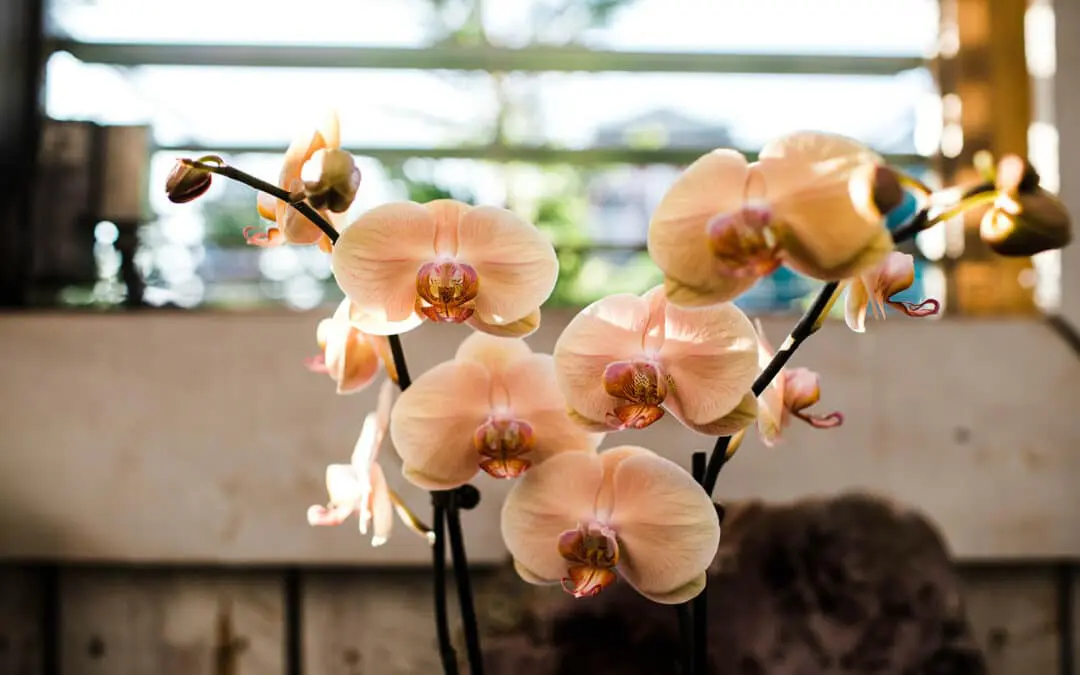
by Emily Vogler | Nov 10, 2022
The holiday season is full of events and celebrations but also can be very stressful while you are trying to find a unique and special gift. Orchids are a perfect holiday gift for your family, friends, host or hostess of the party you are invited to. Watch as Brennan walks you through orchid care tips and tricks to help them stay happy and blooming after you receive one as a gift (or treat yourself to a new plant)!
They are a long blooming gift.
Orchids can bloom anywhere from weeks to months
Striking, elegant, exotic and unique – perfect gifts!
These plants are stunning and you can arrange them quite nicely to become an extraordinary and very impressive gift!
Orchids need very little care.
They’re very low-maintenance plants and need watering once every week or 2 to stay happy. Fertilize frequently during the growing season. Orchids thrive in bright, indirect sunlight. If you’re growing your orchids indoors, place them near a east- or west-facing window. One of the most common mistakes people make when caring for orchids is overwatering. Orchids don’t like their roots to sit in water, so it’s important to let the potting mix dry out between waterings. Water your orchids about once a week, or when the potting mix feels dry to the touch.
Safe for pets and people!
Orchids don’t have loose pollen grains and it makes them a safe gift for allergy sufferers. Also, orchids are safe for pets.
These plants make truly unique gifts that any plant lover would surely love to receive. We have tons in stock right now!

by Emily Vogler | Oct 22, 2022
The Nashville Scene has announced its Best of Nashville Award Winners, and Gardens of Babylon won first place for best lawn service and second place for best nursery/garden center.
From the Scene on Best of Nashville awards:
“A lot has changed here in Music City over the past three-and-a-half decades. Skyscrapers have risen. Restaurants have opened, closed and opened again. The national media has turned its eye on our humble burg, christening us an “It” city before moving on to the Next Big Thing. Publications have launched, others have folded. Floods. Tornadoes. Pandemics. James Beard Awards. Stanley Cup runs.
But for all that’s changed, we here at Nashville’s alternative-weekly newspaper have made sure one thing stays the same: Every year for 30-plus years, we’ve compiled our whopping Best of Nashville issue, rounding up everything that makes our city great with both our readers’ poll and our writers’ choices. In these pages, you’ll find who Nashvillians voted the city’s Best Band, Best Restaurant and Best Barbershop. You’ll also find who our team of writers christened the Best Collegiate Athlete, Best Chef and Best Pop-Up Market. All that and much, much more.“
At Gardens of Babylon, we know to have a healthy and happy life, you need to incorporate nature into your living spaces. The problem is that most people don’t know where to start when it comes to adding plants and landscaping to their in or outdoor spaces, leaving them feeling stuck and uninspired. We believe you should be connected to nature and draw life and strength from it. Over the last 20 years, we have helped thousands of customers across Tennessee turn their yards into beautiful retreats of inspiration. Our eco-friendly approach ensures you get nature’s full benefit – the way it’s intended.
Check out some of the five-star Google reviews we’ve received about our outstanding service:
“GOB is one of my favorite places to find rare exotic plants that I can’t find other places. Their Thai Constellation in the greenhouse is a thing of beauty! I also enjoy how seeing how much joy their staff working have for what they do. Highly recommended.” – Autumn
“We shopped around for a landscape design and build company when we were looking to add a patio to the front of our house. We are on a corner lot and wanted to make sure whatever we did was done right and additive to curb appeal. While Gardens if Babylon was not the lowest estimate, Ryan took the time to answer questions and share a portfolio of work in the design process. Other companies we’re more “take it or leave it”. It was clear from the start that Gardens of Babylon had deep experience and we could trust their work product. We were not disappointed! Communication was thorough throughout the process. The hand offs across teams were seem less to us – from design to project management to build to irrigation. Our build team of Carlos, Rene and Oscar were fabulous. It was clear that they have worked as a team in many projects. Similarly, Jon provided clear daily updates and checked in regularly. Since the work has been completed, we have received many compliments from neighbors with the best one being “it looks like it’s been there all along and fits right in!”. Again, highly recommend Gardens of Babylon for your landscape design and construction needs.” – Scott

by Emily Vogler | Oct 20, 2022
Fall planting is a sure way to have happy plants in spring! A variety of outdoor plants are perfectly happy with being planted in the fall, and even thrive if planted in the cooler autumn months. The following process can be used for a variety of outdoor plants. Plus, the best time to plant most trees, shrubs, and perennials in Tennessee is November through March, due to a lower risk of transplant shock!

Supplies you may need:
- Shovel or spade
- Watering can or hose
- Soil conditioner
- Fertilizer
- Mulch
(Be aware of underground utilities. Call 811 to have utilities marked before digging. It takes 2-3 days, so plan ahead. This limits the risk of breaking a utility wire or pipe which can be dangerous and expensive.)
1. Dig the hole
Dig a hole 2-3 times the diameter of the nursery pot and an inch or two shallower than the depth of the pot. Ex. A pot with a rooting depth of 10” should have an 8” deep hole.
2. Amend the soil
Mix the soil that was removed from the planting pit with soil conditioner/compost in an even ratio.
3. Prep & Place
Check that the soil is moist. If the soil in the pot is dry, water it before planting. Remove the plant from the pot. Massage or prune any circling roots to encourage outward root growth. Place the root ball in the center of the hole. Make sure 1-2” of the root ball is above the top of the hole.
4. Fill the hole
Backfill the hole around the root ball using the blend of soil/soil conditioner/compost. Gently tamp the soil down to remove air pockets.
5. Fertilize
Add slow release fertilizer. Espoma Bio Tone and Plant Tone are great options. Follow application instructions on the packaging.
6. Mulch
Apply mulch in a donut shape extending to the drip line to a depth of 3-4”. Leave a 4-8” ring around the base of the plant without mulch. Avoid piling mulch up on the trunk or stems. Mulch helps retain moisture and reduce weeds.
7. Water
Water the new planting(s) thoroughly. This will help it get established and eliminate unwanted air pockets in the soil. New plantings need to be watered frequently until the plant is established. This may be as often as everyday during the hottest months. It can take up to a year for a plant to become established. Once established, watering will only be needed during times of extended drought. Mulching will greatly reduce watering needs.

by Emily Vogler | Oct 10, 2022
Fall landscape cleanups are a vital step to take to ensure spring success in your lawn and garden beds. They also protect your investment – your landscaping! Plants need proper preparation to endure the rigors of winter. Our landscape company offers landscape cleanups and plant enhancements throughout the year, which includes removal of fall leaves and debris, pruning and trimming at the proper times, creating fresh bed edges to prevent turf grass creep, and installing fresh mulch for protection and also curb appeal. So keep reading! We’re sharing three main reasons why fall cleanups are so important. (Not to mention now is a great time to get the landscape looking tidy for the holidays…)
A fall landscape cleanup protects your turf.
We love the natural look and feel of fallen fall leaves on the lawn, but if turf health is the goal, it is important to remove them and toss them in the compost. A layer of soggy fall leaves creates a barrier on top of the turf blocking water, sunlight, and healthy air flow, which can create disease and unsightly brown patches. Therefore, we regularly remove leaves and compost them when working in all our clients’ landscapes, and recommend our DIY gardeners do the same.

Fall cleanups reduce disease spread in spring.
Not only does a landscape cleanup in the fall reduce diseases in turf, but it keeps your landscape plants and vegetable gardens healthier when the temperatures rise. Removing old, dead, and diseased plant material in fall will reduce the spread of fungal and bacterial infections in spring. Any rotted and unharvested fruits, dead branches & limbs, and diseased plant parts can all be composted to create a healthier winter environment before temperatures rise again.

Fall cleanups protect plants.
After removing plant debris such as fallen leaves from your landscape beds and vegetable gardens, it is important to replace it with a disease-free mulch. Mulch protects the roots of perennial plants and the topsoil during winter’s harsh conditions. Our landscape company installs a variety of mulches in our client’s landscapes, but mostly a natural no-dye pine-bark mulch to retain moisture, vital nutrients, and leave the landscape looking fresh. In vegetable beds, cover crop such as clover that double as a mulch and also a spring fertilizer when tilled into the soil are best. Pruning excess limbs and branches during fall also protects plants from winter’s snow and ice and reduces breakage.
—
If you would like to speak to one of our landscape experts about your fall cleanup project, schedule a free phone consultation.

by Emily Vogler | Sep 25, 2022
October is a great month to get all the last minute items done on your property. It is still warm enough … but not for long. This list will help you figure out what needs to be done before the cold sets in!
- Fertilize established fescue lawns with a winterizer for better growth in the spring.
- Mulch or gather leaves regularly as they drop, as a thick leaf layer on lawns can promote insects and diseases and delay winter dormancy.
- Continue to mow the lawn, as needed. Mow one last time before the first freeze. Grass is much more likely to develop turf diseases if it goes into dormancy at a taller height.
- Late October is an excellent time for planting shrubs and hardy trees, or transplanting large woody shrubs or ornamental trees.
- Tidy the garden by removing spent summer annuals, pruning dead bloom spikes off perennials, and re-shaping overgrown perennials later in the season.
- Plant cool-weather annuals like pansies. Add an organic fertilizer such as bone and blood meal, organic matter such as compost, and work it into the bed before planting.
- Plant daffodils, tulips, hyacinths and crocus and other spring flowering bulbs from late October until the ground freezes.
To begin your next project, schedule a phone consultation!
If you would like to work with your existing designer, simply fill in their name in the “Project Details” section.









